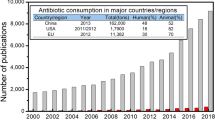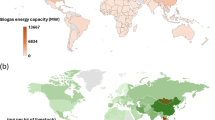Summary
The Center for Veterinary Medicine requires strain/construct-specific data for recombinant fermentation organisms used in the production of animal drugs and feed additives. Fermentation plant biocontainment schemes are chosen based, in part, upon the ability of the organism to survice and persist in the environment and to transfer genetic information to indigenous organisms. Survival and persistence study methods may include one of the following ecosystems: activated sludge, mammalian gut, soil or river water. Gene transfer protocols can be incorporated into a persistence study. These studies are designed to show that the recombinant construct behaves similarly to the host in a representative ecosystem where the organism could be introduced inadvertently. The studies need to provide repeatable results and reflect current state-of-art design and methods. Data verification is conducted by FDA investigators during Good Laboratory Practice inspections. Biocontainment guidelines, such as those developed by the NIH Recombinant DNA Advisory Committee, set general biocontainment goals for large groupings of recombinant organisms. The FDA, as required under the National Environmental Policy Act, must base its decision making on verifiable scientific data specific to each application. Therefore, in addition to using these guidelines as benchmarks, sponsors are required to submit strain/construct-specific data to support the selection of an appropriate biocontainment level. Once additional well-controlled studies for a variety of constructs are available, broader generalizations as to biocontainment may be drawn.
Similar content being viewed by others
References
Balbas, P., X. Soberon, E. Merino, M. Zurita, H. Lomeli, F. Valle, N. Flores and F. Bolivar. 1986. Plasmid pBR322 and its special-purpose derivatives — a review. Gene 50: 3–40.
Cano, R.J. and J.S. Colume. 1986. Diseases of the urogenital tract. In: Microbiology. pp. 635–655, West Publishing Company, St. Paul.
Cano, R.J. and J.S. Colume. 1986. Microbial genetics. In: Microbiology. pp. 203–240, West Publishing Company, St. Paul.
Cohen, P.S. and D.C. Laux. 1985.E. coli colonization of the mammalian colon: understanding the process. Recomb. DNA Tech. Bull. 8: 51–54.
Cohen, P.S., R.W. Pilsucki, M.L. Myhal, C.A. Rosen, D.C. Laux and V.J. Cabelli. 1979. Colonization potentials of male and femaleE. coli K-12 strains,E. coli B, and human fecalE. coli strains in the mouse GI tract. Recomb. DNA Tech. Bull. 2: 106–113.
Council on Environmental Quality. 1978. Regulations for implementing the procedural provisions of the National Environmental Policy Act. 40 CFR 1500-1508. 43 FR 55978.
DeFlaun M.F. and S.B. Levy. 1989. Genes and their varied hosts. In: Gene Transfer in the Environment (S.B. Levy and R.V. Miller, eds.), pp. 1–32, McGraw-Hill Publishing Company, New York.
Devanas, M.A. and G. Stotzky. 1986. Fate in soil of a recombinant plasmid carrying aDrosophila gene. Current Microbiol. 13: 279–283.
Gealt, M., M.D. Chai, KB. Alpert and J.C. Boyer. 1985. Transfer of plasmids pBR322 and pBR325 in wastewater from laboratory strains ofEscherichia coli to bacteria indigenous to the waste disposal system. Appl. Environ. Microbiol. 49: 836–841.
Gealt, M.A. 1988. Recombinant DNA plasmid transmission to indigenous organisms during waste treatment. Water Sci. Tech. 20: 179–184.
Jain, R.K., R.S. Burlage and G.S. Sayler. 1988. Methods for detecting recombinant DNA in the environment CRC Crit. Rev. Biotechnol. 8(1): 33–84.
Levin, B.R. and V.A. Rice. 1980. The kinetics of transfer of nonconjugative plasmids by mobilizing conjugative factors. Genet. Res. Camb. 35: 241–259.
Levy, S.B., B. Marshall and D. Rowse-Eagle. 1980. Survival ofEscherichia coli host-vector systems in the mammalian intestine. Science 209: 391–394.
McPherson, P. and M.A. Gealt. 1986. Isolation of indigenous wastewater bacterial strains capable of mobilizing plasmid pBR325. Appl. Environ. Microbiol. 51(5): 904–909.
National Environmental Policy Act (NEPA) 1969. 42 U.S.C. 4321–4347.
National Institutes of Health. 1986. Guidelines for research involving recombinant DNA molecules. 51 FR 16958.
Organisation For Economic Co-Operation and Development. 1986. Recombinant DNA Safety Considerations. Paris, France.
Saye, D.J. and R.V. Miller. 1989. The aquatic environment: consideration of horizontal gene transmission in a diversified habitat. In: Gene Transfer in the Environment (S.B. Levy and R.V. Miller, eds.), pp. 223–259, McGraw-Hill Publishing Company, New York.
Sjogren, R.E. 1989. Soil survival ofEscherichia coli: laboratory microcosms and field plots. Abstr. Ann. Meet. Am. Soc. Microbiol. 89:
Steffan, R.J., A. Breen, R.M. Atlas and G.S. Sayler. 1989. Monitoring genetically engineered microorganisms in fresh-water microcosms. J. Indust. Microbiol. 4: 441–446.
Stotzky, G. 1989. Gene transfer among bacteria in soil. In: Gene Transfer in the Environment (S.B. Levy and R.V. Miller, eds.), pp. 165–222, McGraw-Hill Publishing Company, New York.
Tiedje, J.M., R.K. Colwell, Y.L. Grossman, R.E. Hodson, R.E. Lenski, R.N. Mack and P.J. Regal. 1989. The planned introduction of genetically engineered organisms: ecological considerations and recommendations. Ecology 70: 298–315.
United States Environmental Protection Agency, Biotechnology Science Advisory Committee: Subcommittee on Mobile Genetic Elements. 1989. Issue Paper: Bacterial mobile genetic elements.
Zeph, L.R. and G. Stotzky. 1989. Use of a biotinylated DNA probe to detect bacteria transduced by bacteriophage P1 in soil. Appl. Environ. Microbiol. 55(3): 661–665.
Zeph, L.R., M.A. Onaga and G. Stotzky. 1988. Transduction ofEscherichia coli by bacteriophage P1 in soil. Appl. Environ. Microbiol. 54: 1731–1737.
Author information
Authors and Affiliations
Rights and permissions
About this article
Cite this article
Jones, R.A., Matheson, J.C. Relationship between safety data and biocontainment design in the environmental assessment of fermentation organisms — An FDA perspective. Journal of Industrial Microbiology 11, 217–222 (1993). https://doi.org/10.1007/BF01569594
Issue Date:
DOI: https://doi.org/10.1007/BF01569594




